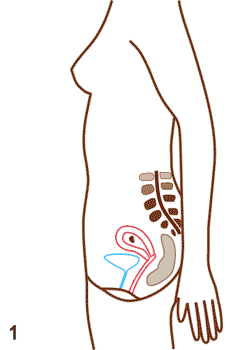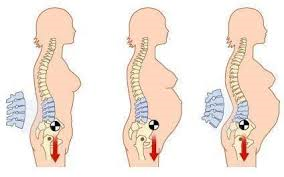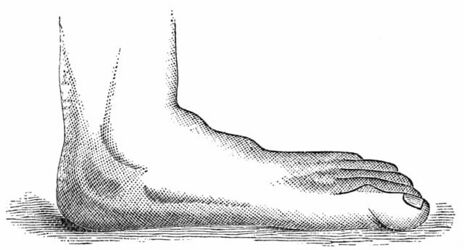The Biomechanics of Pregnancy
Original Editor - Areeba Raja
Top Contributors - Areeba Raja and Kim Jackson
Introduction[edit | edit source]
Pregnancy, as a natural and physiological process, produces in a woman a series of changes involving the motor system. Weight gain, especially changes within its distribution requires functional adaptation of the musculoskeletal system. These changes make both the posture and gait pattern of pregnant women different from non-pregnant subjects.[1]
The addition of anterior mass on the trunk in a pregnant woman changes the body's center of mass if there is not a concomitant change in posture. Consequently, kinematic adjustments are made to improve stability, allowing safer gait for the pregnant woman, but may be only mechanical in nature. The adjustments do reduce the kinetic effect of the increased mass as total mass normalized moments decrease.[2]
Biomechanical Considerations[edit | edit source]
During pregnancy, a number of biomechanical and hormonal changes occur that can alter spinal curvature, balance, and gait patterns by affecting key areas of the human body. This can greatly impact quality of life (QOL) by increasing back pain and the risk of falls.[3]
The overall postural effect of pregnancy by the final month is as follows:[2][4][5][6][7][8][9]
- Anterior tilt of pelvis with hyperextended knees.
- Accentuated lumbar lordosis with a short radius curve.
- Posterior gravity line.
- Hyper kyphosis of the upper thoracic.
- Protracted shoulders.
- Anterior angulation of the cervical region.
- Extension of the occiput on atlas.
- Associated with these postural changes is a waddling gait pattern.
The video below demonstrates how posture changes as the fetus grows.
Changes in the Spine[edit | edit source]
- Pregnant women with anterior translation of their center of mass have been shown to lack positional adjustment of lumbar lordosis, and the force of gravity, when more distant from the hip, generates a larger hip moment and an unstable upper body.[10]
- Many pregnant women demonstrate a sway-back posture, whereby the upper trunk is displaced posterior to the lower body causing the center of gravity to shift further backward, and increases the tone of head and neck muscles, causing the head to shift forward to compensate for the change in center of gravity and prevent falling.[10]
Changes in the Knee[edit | edit source]
- As pregnant women experience an anterior shift in center-of-gravity, their knees hyperextend to maintain balanced, upright posture. Knee hyperextension tenses the anterior cruciate ligament (ACL) as it impinges against the femoral notch, which may cause the ACL to adapt and lengthen throughout pregnancy.[11]
- Knee laxity during pregnancy reaches a constant level before the fifth month of pregnancy, which suggests that laxity increases early in pregnancy; it decreased significantly by about 14% 4 months postpartum.[12]
- The knee is delicately balanced to maintain stability while also allowing for a wide range-of-motion during activities. Perturbations to this balance, such as those caused by the non-uniform changes in joint laxity which persist following pregnancy, could potentially increase the risk of developing OA and other musculoskeletal disorders in women in their post-reproductive years.[11]
Changes in the Ankle and Foot[edit | edit source]
- Changes in the biomechanics of feet during pregnancy and puerperium, indicates an increase in circumference measurement and a reduction in plantar arch while the length and width of the foot increases with increased body weight and ligamentous laxity.[13]
- During pregnancy, forces exerted at the soles of the feet shift from the posterior to the anterior with consequent increases at the forefoot and, more prominently, at the midfoot.[14]
- Flat feet add stress on the foot and causes inflammation of plantar fascia and increases strain on the feet, calves and sometimes the back.[15]
- The plantar loading would redistribute as the body weight increase and centre of mass relocate, which is reported to be correlated with foot complaints.[16]
Biomechanical Alterations in Gait[edit | edit source]
Walking is the most essential daily activity for the human body; however, there are many biomechanical changes in gait during pregnancy.[17] Pregnant women altered gait pattern to adapt the weight gain and the shift of centre of gravity. The gait of pregnant women undergoes following modifications:[1][17][18]
Gait Speed[edit | edit source]
Natural locomotion of pregnant women is characterized by slower speed and lower frequency and length of steps, as compared to the pre-pregnancy and postpartum state.[1][19] Pregnant women tend to avoid the large relative phase between pelvic and thoracic rotations that is typical for high walking velocities, possibly because the moments of inertia of their pelvis and thorax have increased which renders the control of relative phase more critical.[20]
Gait Cycle[edit | edit source]
A significant decrease in the length of the gait cycle is observed in pregnant women.[21] There is an increase in double support time compared to post-partum and nulliparous women. These are fine adjustments that minimize the time on one leg to reduce muscle solicitation. Thus, pregnant women exaggerate transition phases in order to increase the security of gait.[22]
Table below
| Spatial and Temporal Parameters of Gait | |
| Stride Length | decreases as pregnancy progresses[3][23][24][21] |
| Stride Width | remains unchanged[23] |
| Step Length | Decreases[21][25] |
| Step Width | Increases as the pregnancy progresses[24][21] |
| Single Support Time | Decreases[21][25] |
| Double Support Time | Increases between trimesters[23][21][25] |
| Base of Support | Increases[21] |
| Ground Reaction Force | Decrease in late pregnancy.[25][26][27] |
| Joint Kinematic Parameters | |
| Sagittal Plane | |
| Pelvis | Increase in anterior tilt about 5 degrees[21][28] |
| Hip | Increase flexion during stance phase[21][29][30] |
| Knee | Increase flexion during terminal stance[21] |
| Ankle | Decrease dorsiflexion and plantarflexion[21][30] |
| Frontal Plane | |
| Pelvis | Increase in pelvic separation width and reduction in the amplitude of the unilateral elevation of the pelvis.[21] |
| Hip | Decrease in abduction.[16] |
| Joint Kinetic Parameters | |
| Sagittal Plane | |
| Hip | Significant increase in the hip extensors moment[21] |
| Knee | Significant decrease in the knee extensor moment[21] |
| Ankle | Significant decrease in the ankle plantar flexor moment[21] |
| Frontal Plane | |
| Hip | Increase in hip abductors moment[21] |
| Knee | Increase in knee adductors moment[21] |
Sit-to-Stand during Pregnancy[edit | edit source]
Rising to stand from a chair becomes more difficult to perform as pregnancy progresses, which may lead to altered biomechanics affecting the musculoskeletal demands on the body segments.[31] [32] Pregnant women may use following temporal-spatial, kinematic and kinetic strategies during the transfer:[33]
- Reduction in pre-extension time.
- Increased base of support.
- Decreased hip joint extension velocity.
- Decreased and delayed vertical Ground Reaction Force (GRF)
The biomechanical alterations may have been used to control the momentum which would otherwise be amplified by the increased mass of the trunk. The need to control upright balance at the end of rising to stand is paramount and subjects will voluntarily limit the propulsive impulse to maintain upright stance under varying conditions.[33] During rising, pregnant women dampened the propulsion is attributable to increased uterus volume, and they enhanced the forward propulsion at gait initiation. To ensure safe motion, pregnant women should not initiate gait until reaching a stable standing position after rising.[31]
The video below shows the safe way of transference from sitting to standing during pregnancy
Stand-to-Sit during Pregnancy[edit | edit source]
- The physical and physiological changes during pregnancy may necessitate a change in stand-to-sit kinematic performance as follows:[34]
- Hip and spine motion change for pregnant women performing a sitting task as Hip range of motion and standing angle changed in favor of spine motion.
- Postural changes related to gestational lordosis affect stand-to-sit changes.
- Coordination changes away from the hip during the first and last parts of sitting:
- Joint coordination shifts from hip dominant to spine- and shoulder-dominate coordination just before the start of sitting motion.
- Hip-knee joint coordination just before seat contact shifts from hip to a knee-dominant motion during pregnancy
Discomforts of Pregnancy[edit | edit source]
Pregnancy-induced biomechanical, hormonal, and vascular changes are likely to give rise to a wide variety of musculoskeletal problems. The enlarging uterus alters body’s centre of gravity and applies mechanical stress on the body. Joint laxity develops secondary to hormone level fluctuations. Fluid retention leads to compression of soft tissues in pregnancy. Consequently, a pregnant woman is susceptible to musculoskeletal injuries.[35]
Postural changes during pregnancy may cause the following complaints:[36]
Implications for the Physiotherapist[edit | edit source]
As part of their ante-natal care of pregnant women, physiotherapists are concerned to encourage the maintenance of 'good posture'. Examination of the standard deviations for initial posture and the variety in magnitude and nature of postural changes during pregnancy highlight the importance of the physiotherapist assessing each patient's posture early in the ante-natal program. It is obviously important not only to determine initial postural alignment, but also to evaluate it progressively, so that suitable preventive and therapeutic measures may be taken.[37]
Monitoring of postural changes, using the simple inclinometer or clinometer, together with comprehensive recordings of pain during the ante-natal period could produce important data for further guidance of those concerned with the care of the pregnant woman. The physiotherapist could explore whether the woman's initial posture had a significant influence on the development of particular postural changes during pregnancy, or on the development of pain.[37]
Clinical Bottom Line[edit | edit source]
Considering the impact of relative mass gain on postural and gait adaptations, these results demonstrate the importance of antenatal exercise programs that focus on core strength and pelvic stability that may improve mobility and potentially mitigate the risk of falling during walking.[38] The literature suggests that there are large inter-individual differences in postural adaptations to pregnancy, with, perhaps, each woman solving the problems in her own way.[20]
References[edit | edit source]
- ↑ 1.0 1.1 1.2 Forczek W;Staszkiewicz R. Changes of kinematic gait parameters due to pregnancy. Acta of bioengineering and biomechanics [Internet]. 2012 [cited 2021 Nov 25];14(4).
- ↑ 2.0 2.1 Ogamba MI, Loverro KL, Laudicina NM, Gill SV, Lewis CL. Changes in Gait with Anteriorly Added Mass: A Pregnancy Simulation Study. Journal of Applied Biomechanics [Internet]. 2016 Aug [cited 2021 Nov 21];32(4):379–87.
- ↑ 3.0 3.1 Conder R, Zamani R, Akrami M. The Biomechanics of Pregnancy: A Systematic Review. Journal of Functional Morphology and Kinesiology [Internet]. 2019 Dec 2 [cited 2021 Nov 25];4(4):72.
- ↑ Fligg DB. Biomechanical and treatment considerations for the pregnant patient. The Journal of the Canadian Chiropractic Association [Internet]. 1986 [cited 2021 Nov 25];30(3):145–7.
- ↑ Yoo H, Shin D, Song C. Changes in the spinal curvature, degree of pain, balance ability, and gait ability according to pregnancy period in pregnant and nonpregnant women. Journal of Physical Therapy Science [Internet]. 2015 [cited 2021 Nov 25];27(1):279–84.
- ↑ Petrocco-Napuli K. Pregnancy and the Impact on the Lower Extremity [Internet]. [cited 2021 Nov 21].
- ↑ Franklin ME, Conner-Kerr T. An Analysis of Posture and Back Pain in the First and Third Trimesters of Pregnancy. Journal of Orthopaedic & Sports Physical Therapy [Internet]. 1998 Sep [cited 2021 Nov 25];28(3):133–8.
- ↑ Gilleard WL, Crosbie J, Smith R. Static trunk posture in sitting and standing during pregnancy and early postpartum. Archives of Physical Medicine and Rehabilitation [Internet]. 2002 Dec [cited 2021 Nov 27];83(12):1739–44.
- ↑ Ribeiro AP, João SMA, Sacco ICN. Static and Dynamic Biomechanical Adaptations of the Lower Limbs and Gait Pattern Changes during Pregnancy. Women’s Health [Internet]. 2013 Jan [cited 2021 Nov 28];9(1):99–108.
- ↑ 10.0 10.1 OKANISHI N, KITO N, AKIYAMA M, YAMAMOTO M. Spinal curvature and characteristics of postural change in pregnant women. Acta Obstetricia et Gynecologica Scandinavica [Internet]. 2012 Jun 18 [cited 2021 Nov 25];91(7):856–61.
- ↑ 11.0 11.1 Chu SR, Boyer EH, Beynnon B, Segal NA. Pregnancy Results in Lasting Changes in Knee Joint Laxity. PM&R [Internet]. 2019 Feb [cited 2021 Nov 25];11(2):117–24.
- ↑ Dumas GA, Reid JG. Laxity of Knee Cruciate Ligaments During Pregnancy. Journal of Orthopaedic & Sports Physical Therapy [Internet]. 1997 Jul [cited 2021 Nov 25];26(1):2–6.
- ↑ Wittkopf PG, Kretzer J, Borges DM, Santos GM, Sperandio FF. Características biomecânicas dos pés no período gravídico-puerperal: estudo de caso. Scientia Medica [Internet]. 2015 Jun 10 [cited 2021 Nov 25];25(1):19688.
- ↑ VAROL T, GÖKER A, CEZAYİRLİ E, ÖZGÜR S, TUÇ YÜCEL A. Relation between foot pain and plantar pressure in pregnancy. TURKISH JOURNAL OF MEDICAL SCIENCES [Internet]. 2017 [cited 2021 Nov 25];47:1104–8. Available from: https://pubmed.ncbi.nlm.nih.gov/29154449/
- ↑ Ghait AS, Elhosary EA, Abogazya AA. Assessment of Foot Biomechanics through Measuring of the Plantar Pressure during the Last Trimester of Pregnancy. Journal of Advances in Medicine and Medical Research [Internet]. 2018 Sep 20 [cited 2021 Nov 25];27(7):1–6.
- ↑ 16.0 16.1 Mei Q, Gu Y, Fernandez J. Alterations of Pregnant Gait during Pregnancy and Post-Partum. Scientific Reports [Internet]. 2018 Feb 2 [cited 2021 Nov 27];8(1).
- ↑ 17.0 17.1 Zhang Y, Lu H, Yaodong Gu, Nanzhi Hu. Characteristics of the centre of pressure progression for pregnant women during walking [Internet]. ResearchGate. Inderscience; 2015 [cited 2021 Nov 26].
- ↑ Bertuit J;Leyh C;Rooze M;Feipe V. Pregnancy-related changes in center of pressure during gait. Acta of bioengineering and biomechanics [Internet]. 2017 [cited 2021 Nov 26];19(4).
- ↑ Sorani D, Jani R, Anand N. Gait Analysis during Pregnancy. International Journal of Health Sciences & Research (wwwijhsrorg) [Internet]. 2016 [cited 2021 Nov 28];6:266.
- ↑ 20.0 20.1 Wu W, Meijer OG, Lamoth CJC, Uegaki K, van Dieën JH, Wuisman PIJM, et al. Gait coordination in pregnancy: transverse pelvic and thoracic rotations and their relative phase. Clinical Biomechanics [Internet]. 2004 Jun [cited 2021 Nov 27];19(5):480–8.
- ↑ 21.00 21.01 21.02 21.03 21.04 21.05 21.06 21.07 21.08 21.09 21.10 21.11 21.12 21.13 21.14 21.15 21.16 Branco M, Santos-Rocha R, Vieira F. Biomechanics of Gait during Pregnancy. The Scientific World Journal [Internet]. 2014 [cited 2021 Nov 28];2014:1–5.
- ↑ Bertuit J, Feipel V, Rooze M. Temporal and spatial parameters of gait during pregnancy. 2015 [cited 2021 Nov 28];17(2).
- ↑ 23.0 23.1 23.2 Branco M, Santos-Rocha R, Aguiar L, Vieira F, Veloso A. Kinematic Analysis of Gait in the Second and Third Trimesters of Pregnancy. Journal of Pregnancy [Internet]. 2013 [cited 2021 Nov 27];2013:1–9.
- ↑ 24.0 24.1 Gilleard WL. Trunk motion and gait characteristics of pregnant women when walking: report of a longitudinal study with a control group. BMC Pregnancy and Childbirth [Internet]. 2013 Mar 20 [cited 2021 Nov 27];13(1).
- ↑ 25.0 25.1 25.2 25.3 Błaszczyk JW, Opala-Berdzik A, Plewa M. Adaptive changes in spatiotemporal gait characteristics in women during pregnancy. Gait & Posture [Internet]. 2016 Jan [cited 2021 Nov 27];43:160–4.
- ↑ Gimunova M, Kasović M, Zvonar M, Damir Knjaz. Analysis of ground reaction force in gait during different phases of pregnancy [Internet]. ResearchGate. unknown; 2015 [cited 2021 Nov 27].
- ↑ Branco M, Santos-Rocha R, Vieira F, Aguiar L, Veloso AP. Three-Dimensional Kinetic Adaptations of Gait throughout Pregnancy and Postpartum. Scientifica [Internet]. 2015 [cited 2021 Nov 28];2015:1–14.
- ↑ Foti T;Davids JR;Bagley A. A biomechanical analysis of gait during pregnancy. The Journal of bone and joint surgery American volume [Internet]. 2014 [cited 2021 Nov 28];82(5).
- ↑ Catena RD, Bailey JP, Campbell N, Stewart BC, Marion SJ. Correlations between joint kinematics and dynamic balance control during gait in pregnancy. Gait & Posture [Internet]. 2020 Jul [cited 2021 Nov 27];80:106–12.
- ↑ 30.0 30.1 Ribeiro AP, João SMA, Sacco ICN. Static and Dynamic Biomechanical Adaptations of the Lower Limbs and Gait Pattern Changes during Pregnancy. Women’s Health [Internet]. 2013 Jan [cited 2021 Nov 27];9(1):99–108.
- ↑ 31.0 31.1 Sunaga Y, Anan M, Shinkoda K. Biomechanics of rising from a chair and walking in pregnant women. Applied Ergonomics [Internet]. 2013 Sep [cited 2021 Nov 27];44(5):792–8.
- ↑ Lou S-Z, Chou Y-L, Chou P-H, Lin C-J, Chen U-C, Su F-C. Sit-to-stand at different periods of pregnancy. Clinical Biomechanics [Internet]. 2001 Mar [cited 2021 Nov 27];16(3):194–8.
- ↑ 33.0 33.1 Gilleard W, Crosbie J, Smith R. A longitudinal study of the effect of pregnancy on rising to stand from a chair. Journal of Biomechanics [Internet]. 2008 Jan [cited 2021 Nov 27];41(4):779–87.
- ↑ Catena RD, Bailey JP, Campbell N, Music HE. Stand-to-sit kinematic changes during pregnancy correspond with reduced sagittal plane hip motion. Clinical Biomechanics [Internet]. 2019 Jul [cited 2021 Nov 27];67:107–14.
- ↑ Kesikburun S, Güzelküçük Ü, Fidan U, Demir Y, Ergün A, Tan AK. Musculoskeletal pain and symptoms in pregnancy: a descriptive study. Therapeutic Advances in Musculoskeletal Disease [Internet]. 2018 Nov 19 [cited 2021 Nov 27];10(12):229–34.
- ↑ OKANISHI N, KITO N, AKIYAMA M, YAMAMOTO M. Spinal curvature and characteristics of postural change in pregnant women. Acta Obstetricia et Gynecologica Scandinavica [Internet]. 2012 Jun 18 [cited 2021 Nov 27];91(7):856–61.
- ↑ 37.0 37.1 BULLOCK JE, JULL GA, BULLOCK MI. The Relationship of Low Back Pain to Postural Changes During Pregnancy. Australian Journal of Physiotherapy [Internet]. 1987 [cited 2021 Nov 27];33(1):10–7. A
- ↑ Krkeljas Z. Changes in gait and posture as factors of dynamic stability during walking in pregnancy. Human Movement Science [Internet]. 2018 Apr [cited 2021 Nov 28];58:315–20.










